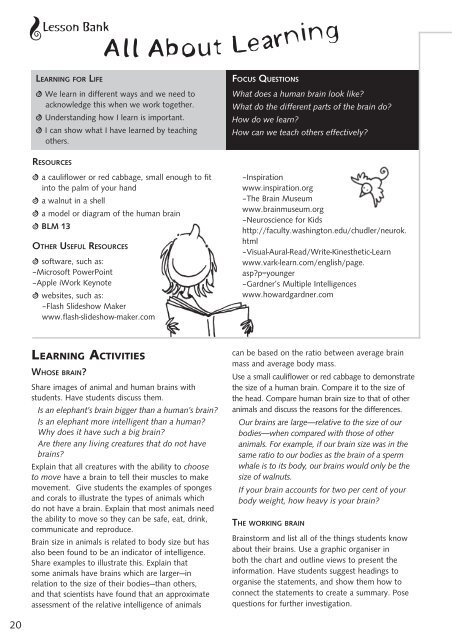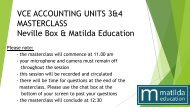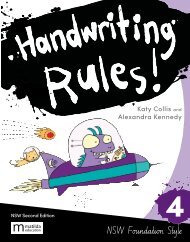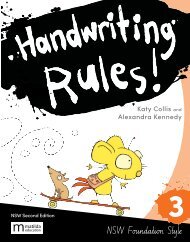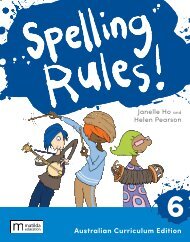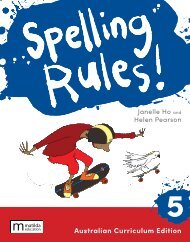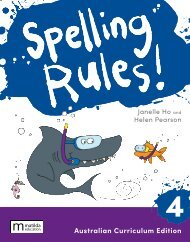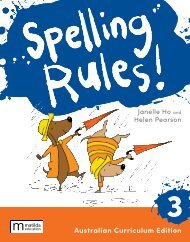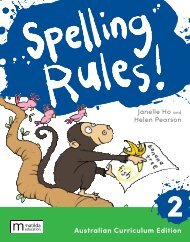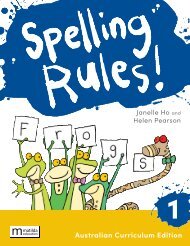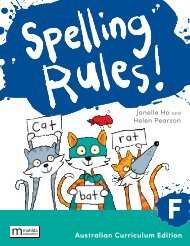All You Need to Teach - Info Literacy 10+
Create successful ePaper yourself
Turn your PDF publications into a flip-book with our unique Google optimized e-Paper software.
Lesson Bank<br />
<strong>All</strong> About Learning<br />
Learning for Life<br />
V We learn in different ways and we need <strong>to</strong><br />
acknowledge this when we work <strong>to</strong>gether.<br />
V Understanding how I learn is important.<br />
V I can show what I have learned by teaching<br />
others.<br />
Focus Questions<br />
What does a human brain look like?<br />
What do the different parts of the brain do?<br />
How do we learn?<br />
How can we teach others effectively?<br />
Resources<br />
V a cauliflower or red cabbage, small enough <strong>to</strong> fit<br />
in<strong>to</strong> the palm of your hand<br />
V a walnut in a shell<br />
V a model or diagram of the human brain<br />
V BLM 13<br />
Other Useful Resources<br />
V software, such as:<br />
–Microsoft PowerPoint<br />
–Apple iWork Keynote<br />
V websites, such as:<br />
–Flash Slideshow Maker<br />
www.flash-slideshow-maker.com<br />
–Inspiration<br />
www.inspiration.org<br />
–The Brain Museum<br />
www.brainmuseum.org<br />
–Neuroscience for Kids<br />
http://faculty.washing<strong>to</strong>n.edu/chudler/neurok.<br />
html<br />
–Visual-Aural-Read/Write-Kinesthetic-Learn<br />
www.vark-learn.com/english/page.<br />
asp?p=younger<br />
–Gardner’s Multiple Intelligences<br />
www.howardgardner.com<br />
Learning Activities<br />
Whose brain?<br />
Share images of animal and human brains with<br />
students. Have students discuss them.<br />
Is an elephant’s brain bigger than a human’s brain?<br />
Is an elephant more intelligent than a human?<br />
Why does it have such a big brain?<br />
Are there any living creatures that do not have<br />
brains?<br />
Explain that all creatures with the ability <strong>to</strong> choose<br />
<strong>to</strong> move have a brain <strong>to</strong> tell their muscles <strong>to</strong> make<br />
movement. Give students the examples of sponges<br />
and corals <strong>to</strong> illustrate the types of animals which<br />
do not have a brain. Explain that most animals need<br />
the ability <strong>to</strong> move so they can be safe, eat, drink,<br />
communicate and reproduce.<br />
Brain size in animals is related <strong>to</strong> body size but has<br />
also been found <strong>to</strong> be an indica<strong>to</strong>r of intelligence.<br />
Share examples <strong>to</strong> illustrate this. Explain that<br />
some animals have brains which are larger—in<br />
relation <strong>to</strong> the size of their bodies—than others,<br />
and that scientists have found that an approximate<br />
assessment of the relative intelligence of animals<br />
can be based on the ratio between average brain<br />
mass and average body mass.<br />
Use a small cauliflower or red cabbage <strong>to</strong> demonstrate<br />
the size of a human brain. Compare it <strong>to</strong> the size of<br />
the head. Compare human brain size <strong>to</strong> that of other<br />
animals and discuss the reasons for the differences.<br />
Our brains are large—relative <strong>to</strong> the size of our<br />
bodies—when compared with those of other<br />
animals. For example, if our brain size was in the<br />
same ratio <strong>to</strong> our bodies as the brain of a sperm<br />
whale is <strong>to</strong> its body, our brains would only be the<br />
size of walnuts.<br />
If your brain accounts for two per cent of your<br />
body weight, how heavy is your brain?<br />
The working brain<br />
Brains<strong>to</strong>rm and list all of the things students know<br />
about their brains. Use a graphic organiser in<br />
both the chart and outline views <strong>to</strong> present the<br />
information. Have students suggest headings <strong>to</strong><br />
organise the statements, and show them how <strong>to</strong><br />
connect the statements <strong>to</strong> create a summary. Pose<br />
questions for further investigation.<br />
20


